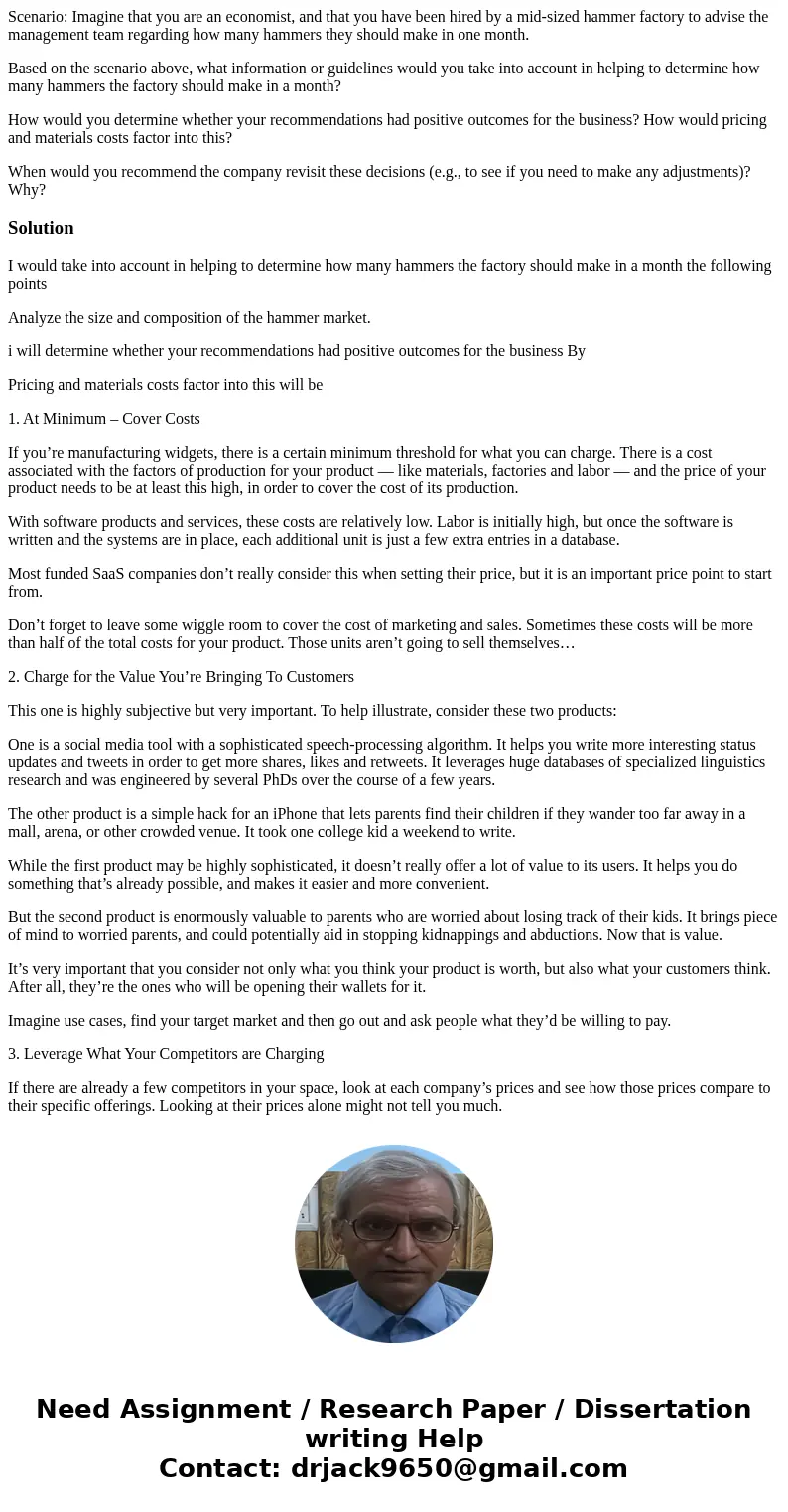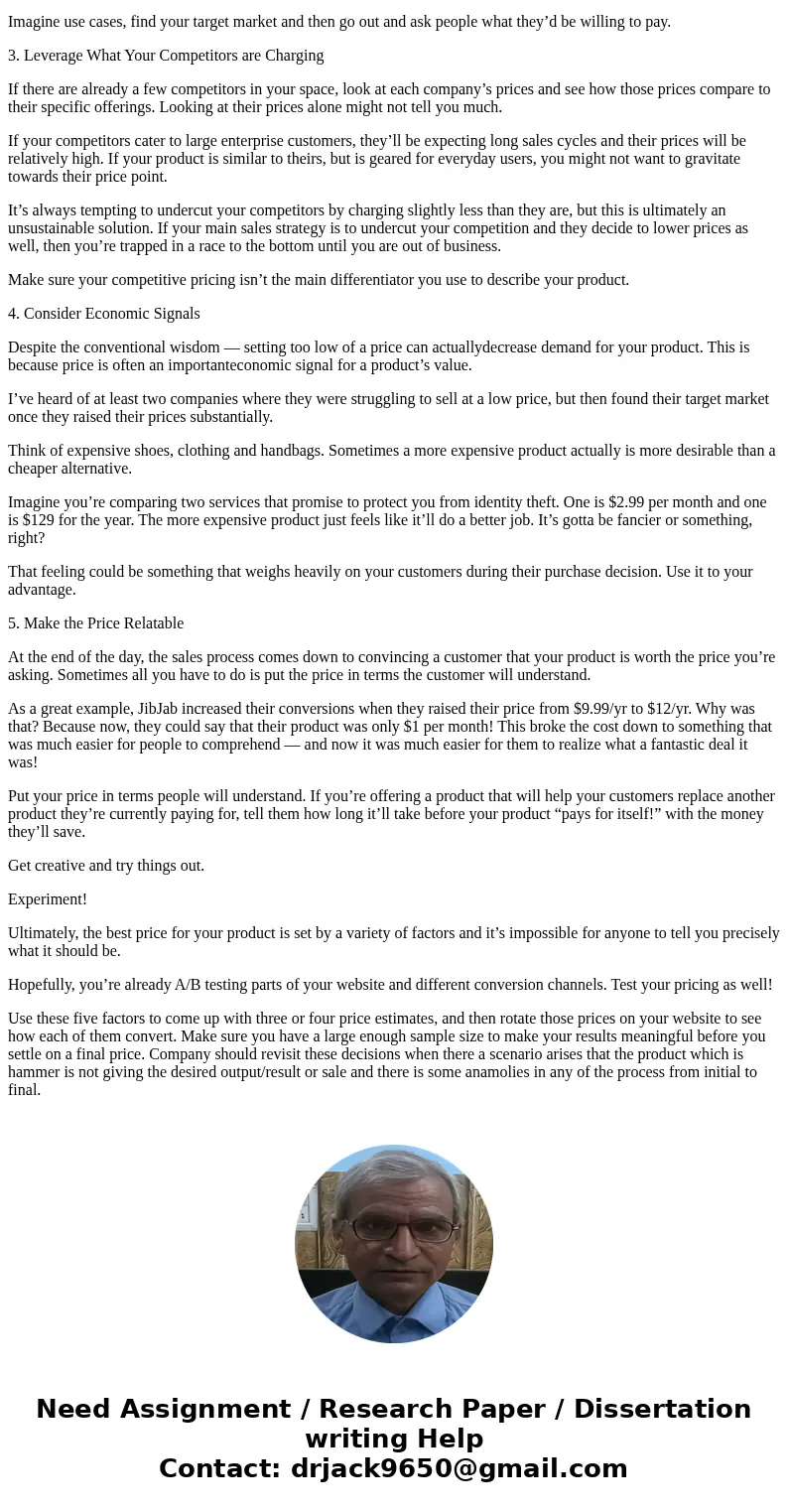Scenario Imagine that you are an economist and that you have
Scenario: Imagine that you are an economist, and that you have been hired by a mid-sized hammer factory to advise the management team regarding how many hammers they should make in one month.
Based on the scenario above, what information or guidelines would you take into account in helping to determine how many hammers the factory should make in a month?
How would you determine whether your recommendations had positive outcomes for the business? How would pricing and materials costs factor into this?
When would you recommend the company revisit these decisions (e.g., to see if you need to make any adjustments)? Why?
Solution
I would take into account in helping to determine how many hammers the factory should make in a month the following points
Analyze the size and composition of the hammer market.
i will determine whether your recommendations had positive outcomes for the business By
Pricing and materials costs factor into this will be
1. At Minimum – Cover Costs
If you’re manufacturing widgets, there is a certain minimum threshold for what you can charge. There is a cost associated with the factors of production for your product — like materials, factories and labor — and the price of your product needs to be at least this high, in order to cover the cost of its production.
With software products and services, these costs are relatively low. Labor is initially high, but once the software is written and the systems are in place, each additional unit is just a few extra entries in a database.
Most funded SaaS companies don’t really consider this when setting their price, but it is an important price point to start from.
Don’t forget to leave some wiggle room to cover the cost of marketing and sales. Sometimes these costs will be more than half of the total costs for your product. Those units aren’t going to sell themselves…
2. Charge for the Value You’re Bringing To Customers
This one is highly subjective but very important. To help illustrate, consider these two products:
One is a social media tool with a sophisticated speech-processing algorithm. It helps you write more interesting status updates and tweets in order to get more shares, likes and retweets. It leverages huge databases of specialized linguistics research and was engineered by several PhDs over the course of a few years.
The other product is a simple hack for an iPhone that lets parents find their children if they wander too far away in a mall, arena, or other crowded venue. It took one college kid a weekend to write.
While the first product may be highly sophisticated, it doesn’t really offer a lot of value to its users. It helps you do something that’s already possible, and makes it easier and more convenient.
But the second product is enormously valuable to parents who are worried about losing track of their kids. It brings piece of mind to worried parents, and could potentially aid in stopping kidnappings and abductions. Now that is value.
It’s very important that you consider not only what you think your product is worth, but also what your customers think. After all, they’re the ones who will be opening their wallets for it.
Imagine use cases, find your target market and then go out and ask people what they’d be willing to pay.
3. Leverage What Your Competitors are Charging
If there are already a few competitors in your space, look at each company’s prices and see how those prices compare to their specific offerings. Looking at their prices alone might not tell you much.
If your competitors cater to large enterprise customers, they’ll be expecting long sales cycles and their prices will be relatively high. If your product is similar to theirs, but is geared for everyday users, you might not want to gravitate towards their price point.
It’s always tempting to undercut your competitors by charging slightly less than they are, but this is ultimately an unsustainable solution. If your main sales strategy is to undercut your competition and they decide to lower prices as well, then you’re trapped in a race to the bottom until you are out of business.
Make sure your competitive pricing isn’t the main differentiator you use to describe your product.
4. Consider Economic Signals
Despite the conventional wisdom — setting too low of a price can actuallydecrease demand for your product. This is because price is often an importanteconomic signal for a product’s value.
I’ve heard of at least two companies where they were struggling to sell at a low price, but then found their target market once they raised their prices substantially.
Think of expensive shoes, clothing and handbags. Sometimes a more expensive product actually is more desirable than a cheaper alternative.
Imagine you’re comparing two services that promise to protect you from identity theft. One is $2.99 per month and one is $129 for the year. The more expensive product just feels like it’ll do a better job. It’s gotta be fancier or something, right?
That feeling could be something that weighs heavily on your customers during their purchase decision. Use it to your advantage.
5. Make the Price Relatable
At the end of the day, the sales process comes down to convincing a customer that your product is worth the price you’re asking. Sometimes all you have to do is put the price in terms the customer will understand.
As a great example, JibJab increased their conversions when they raised their price from $9.99/yr to $12/yr. Why was that? Because now, they could say that their product was only $1 per month! This broke the cost down to something that was much easier for people to comprehend — and now it was much easier for them to realize what a fantastic deal it was!
Put your price in terms people will understand. If you’re offering a product that will help your customers replace another product they’re currently paying for, tell them how long it’ll take before your product “pays for itself!” with the money they’ll save.
Get creative and try things out.
Experiment!
Ultimately, the best price for your product is set by a variety of factors and it’s impossible for anyone to tell you precisely what it should be.
Hopefully, you’re already A/B testing parts of your website and different conversion channels. Test your pricing as well!
Use these five factors to come up with three or four price estimates, and then rotate those prices on your website to see how each of them convert. Make sure you have a large enough sample size to make your results meaningful before you settle on a final price. Company should revisit these decisions when there a scenario arises that the product which is hammer is not giving the desired output/result or sale and there is some anamolies in any of the process from initial to final.


 Homework Sourse
Homework Sourse